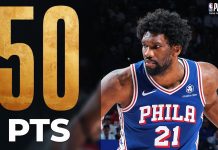Film director Woody Allen, one of the most well-known NBA fans over the years, was a huge Earl Monroe admirer back in the day.
For decades, Allen supported his hometown New York Knicks with unbridled enthusiasm.
Remember when the Knicks were relevant?
You know, way back in the 20th century.
In an illuminating profile posted on NBA.com, the essence of Monroe’s offensive game was described this way: “Observers said that watching him play was like listening to jazz; his moves resembled free-floating improvisations, riffs that took off in midflight and changed direction unpredictably. ‘The thing is, I don’t know what I’m going to do with the ball,’ Monroe once admitted, ‘and if I don’t know, I’m quite sure the guy guarding me doesn’t know either.'”
In other words, improvisational skills were vital to Earl the Pearl’s success, and as an extension the Knickerbockers’ winning ways.
Early days
As a rookie, Monroe scored a career-high 56 points against the visiting Los Angeles Lakers in February 1968. In that game, he made 20 of 33 shots from the field and canned 16 of 22 free throws.
The NCAA Division II legend from Winston-Salem (North Carolina) State averaged a jaw-dropping 41.5 points per game as a college senior. All told, he averaged 26.7 ppg as a collegiate performer over four seasons. It was a sign of things to come.
Monroe’s legendary feats enriched the history of the Baltimore Bullets and the New York Knicks during his pro career. He played a pivotal role for both franchises.
He was a vital cog in the Knicks lineup during the team’s second championship season (1972-73), and without him, the Knicks probably wouldn’t have won it.
Inspiration for Allen
His unique style of play also inspired Allen, who explained why in one of his forays into magazine writing. It’s a stylistic essay full of verve and details.
“My impressions of Monroe then?” Allen wrote for the November 1977 issue of Sport magazine. “I immediately ranked him with Willie Mays and Sugar Ray Robinson as athletes who went beyond the level of sports and sport to the realm of sports as art. Seemingly awkward and yet breathtakingly graceful, with an unimpressive physique, knobby knees, and the tiny ankles of a thoroughbred racehorse, Monroe in seasons would put on exhibition after exhibition of simply magical shot-making. One sportswriter wrote that his misses are more exciting than more guys’ baskets. It’s pointless to describe Monroe on the court. It’s been done a thousand times by good writers who try vainly to communicate in print the excitement with which he plays. They refer to his head fakes, shoulder fakes, spins, double pumps, stutter steps, hip shots, arms and legs flying in different directions at once, but these things in themselves do not sum up the ferocious rush he gives the audience. After all, there are players like Nate Archibald, Dave Bing, Walt Frazier, Julius Erving, Connie Hawkins, who have unusual grace, beauty, and excitement, and who also dip and twist and toss their bodies one way while their arms move another way as they hang in space.
“What makes Monroe different is the indescribable heat of genius that burns deep inside him. Some kind of diabolical intensity comes across his face when he has the ball. One is suddenly transported to a more primitive place. It’s roots time. The eyes are big and white, the teeth flash, the nostrils flare. He dribbles the ball too high, but with a controlled violence. The audience gets high with anticipation of some new type of thrill about to occur. Seconds later he is moving in aggressively, one on one, against a defender and you sense the man is in trouble. Monroe is suddenly double-teamed and now there are two men hanging all over him. Then it happens. A quick twist, a sudden move, and he’s by both men. Either that or a series of flashing arm moves cease with a lightning pass to a teammate he has never even bothered to look at.
“It’s amazing, because the audience’s ‘high’ originates inside Monroe and seems to emerge over his exterior. He creates a sense of danger in the arena and yet has enough wit in his style to bring off funny ideas when he wants to. He has, as an athlete-performer, what few actors possess. Marlon Brando is one such actor. The audience never knows what will happen next and the potential for a sudden great thrill is always present. If we think of an actor like George C. Scott, for instance, we feel he is consistently first rate, but he cannot move a crowd the way Brando does. There is something indescribable in Brando that pins an audience on the edge of its seats at all times. Perhaps because we sense a possible peak experience at any given moment, and when it occurs, the performance transcends mere acting and soars into the sublime. On a basketball court, Monroe does this to spectators.”
Earl the Pearl’s maturation
After his trade to the Knicks in 1971, Monroe needed to alter his game to fit the Knicks’ style of play.
There were skeptics, of course, at first, including Woody Allen.
“Naturally, I was happy to be able to watch him more often, but there were two uneasy questions,” Allen wrote in the magazine piece. “Could he play alongside Walt Frazier? Frazier was then the premier all-around guard in basketball and had set standards so high that years later when he might be off his game a fraction and could no longer single-handedly win games, the fans could not deal with it and turned on him. I found this unforgivable and it certainly says something about the myth of the New York sports fan.”
Allen continued: “In those days, however, Walt Frazier played with a serene brilliance that made it seem that he could steal the ball whenever he wanted to, dribble it behind his back, and score at will. He was wonderful to look at (great posture, perpetual ‘cool’), dressed flashy off the court, drove a Rolls, and got an awful lot of rebounds for a guard.
“Monroe, who when he joined the Knicks reportedly said, ‘Man, I got two Rolls,’ was also used to being the cynosure of his team. He had never had to be overly concerned with defense and never had to share the limelight with anyone approaching Frazier’s greatness. This didn’t worry me, because I felt the two guards would be simply breathtaking together, which they indeed were. They played brilliantly in tandem. Frazier was the steadier of the two. He did everything perfectly. Monroe was, as always, the more dramatic and explosive one. Consequently, when Frazier dribbled up the middle you could count on your two points because of his smooth-as-satin style. When Monroe drove, his lust for danger took him in directions where he might get the ball slapped away or might miss a shot because of spectacular gyrations. Again, like Brando, Monroe takes risks, and while some fail, enough come off to make him an artist.”
Fitting in with the Knicks
Indeed, the Knicks possessed great synergy in those days. Coach Red Holzman figured out how to blend their individual talents into the framework of the team — and it worked wonderfully.
Still, Allen had his doubts.
“The second and more irritating question to me was, can Monroe fit into the flow of team play?” wrote Allen. “Can he become part of that superb combination of Bill Bradley, Walt Frazier, Willis Reed, Dave DeBusschere, etc., that hits the open man, retains poise, and sooner or later grinds up opponents like a well-oiled machine? Some said Monroe would not be able to adjust. …
“The outcome we now know. Monroe learned defense. He modified his style in favor of team play. He scored fewer points. At other times, his irrepressible genius on the court asserted itself. The Knicks won with him until Reed and DeBusschere retired. Then Frazier and Monroe carried the offense…”
And the rest is history.

















